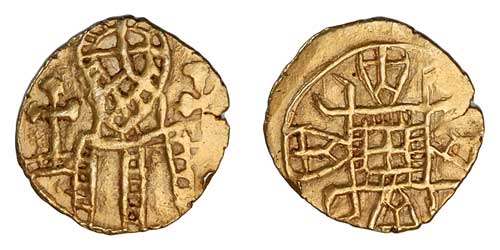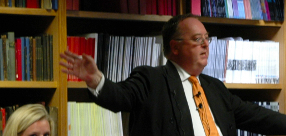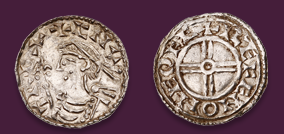
Auction: 1010 - Ancient, English & Foreign Coins, Commemorative Medals & Numismatic Books
Lot: 2
Anglo-Saxon, Northumbria, York, c.640-660, York Group Thrymsa or Shilling, 1.26g (SG 14.43, c.64% gold), Type A, half length facing figure, cross on plinth to left, cross to right, rev. central cross surrounded by a hatched border all within a square with a face attached to each side and pincer shaped extensions at each corner (Sutherland V; Metcalf I, p. 51; Blackburn Type A; Williams type Ai, dies A/b, same dies as EMC 1994.5004, now BMC; N.27/1; S.762A), flan crack at three o´clock, small edge dig, reverse off centre, very fine, the third known of this type, only example outside the British Museum, extremely rare Estimate £ 5,000-6,000 provenance Found near Dunnington, East Riding of Yorkshire. 2009. Recorded with the Fitzwilliam Museum, Cambridge, EMC 2010.0154 The existence of a group of Thrymsas connected with York has been known for over a hundred years and these have been the subject of much comment. The emergence of new finds over the last twenty years has now removed any doubt that might have existed about the origin of these coins and it is now undisputed that these belong to a Northumbrian mid-seventh century gold coinage based on York. The gold content of these coins is similar to the later coins in the Crondall hoard, suggesting they date from the 640s. However difficulties exist in linking the York ´Northern´ Thrymsas too closely to the ´Southern´ Crondall coins so a date range of 640-660 is preferred. Nine examples of ´York´ Thrymsas are recorded with this coin adding a tenth. These are known for three types (A,B,C) suggesting this was a sizable coinage. Type A, first recognised around twenty years ago, is known for this coin and two others. This has a distinctive reverse with a geometric square pattern (noted in two styles), without an inscription and an obverse with the half length standing figure with drapery in three separate vertical hatched bands. Type B, known for a single coin found near Lincoln, has a reverse with a cross within an inner circle and traces of an inscription, whilst the obverse drapery is in three joined bands. Type C, known for six examples, has a reverse similar to Type B but in better style, whilst the obverse drapery is a geometric pattern of horizontal and vertical lines. The design on this type was long thought to represent a building but this is now accepted to be facing half length standing figure. The Christian iconography of these coins links them to the period shortly after arrival of Roman Christianity in the north under Paulinus (d. 633) and its subsequent development in Northumbria, well attested by Bede, in the reigns of St Oswald (633-641), Oswine (644-651) and Oswy (655-670). Corpus As this coin, Type A 1. The British Museum, London, 1.27g, AV 60%, type Ai, found ´Yorkshire´, Sotheby Auction, 9 October 1979, lot 119. Dies A/a 2. The British Museum, London, 1.28g, AV 65%, type Aii, found near York. Dies A/b Type B 1. EMC 1994.5003, 1.28g, found Burton-by-Lincoln, Lincs, 1994 Type C 1. Yorkshire Museum York, SCBI 21/84, now missing, 1.3g. Found York 2. The British Museum, London, 1.11g, 55% AV. Found York 3. The Ashmolean Museaum, Oxford, 1.24g, 52% AV. Found York 4. EMC 1996.1001, 1.25g, Spink Auction 114, 9 July 1996, lot 148. Found Bawtry near Doncaster 5. EMC 2007.0088 (CR 2008.80), 1.29g, 58% AV, found near Pocklington, East Yorks 6. EMC 2008.0432, 1.22g, found, Garton-on-the-Wolds, East Yorks References MAS Blackburn, ´A variant of a Seventh-Century ´York´ group of Shillings found in Lincolnshire.´ NC 154, 1994, pp. 204-208 G Williams, ´The Gold coinage of Seventh Century Northumbria revisited,´ SNC, February 2007, pp. 6-7
Sold for
£11,000




